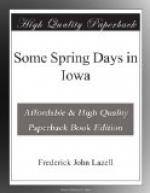Still farther, another unseen stretch of corn land
intervening, the forest crowned ridge meets the soft
sky in a line of lavender, as if it were a strata
cloud lying low on the horizon. From this distance
the lavender and purple are almost changeless every
sunny day the year around. Always the Enchanted
Land and the Delectable Mountains over across the
valley. How like the alluring prospect across
the valley of years! Always the same soft lavender
haze there, while the woods here run through all the
gamut of color, from the downy pinks and whites and
the tender greens of spring through the deeper greens
of summer to the crimson and scarlet of the fall,
and the russets, grays, and coffee-browns of the winter.
When the foliage of the forest has deepened into one
dark shade of verdure then we know that June is far
spent, spring has gone and summer is here. The
uniform green is not monotonous. See the woods
in the hour before sunset when the slanting light
gives the foliage consummate glory. See them again
in the white light of a clear noon when the glazed
leaves seem to reflect a white veil over the pure
verdure; and again when the breeze ripples through
the leafy canopy, showing the silvery under-surfaces
of the maple leaves, the neat spray of the river birches,
the deeply cleft leaves of the scarlet oak and the
finely pinnate leaves of the honey locust. Each
has a glory now peculiar to itself and to June.
There is much beauty of color in the woodland undergrowth.
Tall torches touched with the crimson of the sunset
sky are made of the shell-bark hickory whose inner
bud scales enlarge into enormous, leathery bracts,
often crimsoning into rare brilliance. Circles
of creamy white here and there among the hazel brush
mark the later blossoms of the sweet viburnum.
Sweeping curves like sculptured arms bearing thickly
clustered hemispheres of purplish white are seen on
the rocky slope where the nine-bark grows above the
lingering columbines. White wands which look so
beautiful are merely the ends of the common tall blackberry,
and the wild rose sweetens the same banks. Flattish
clusters of creamy white blossoms are the loose cymes
of the red osier dogwood, but it is not nearly so
beautiful now as it was last January when its blood-red
stems made a striking contrast with the snow.
The bright carmine bark has faded to a dull green
and the shrub is a disappointment now, despite its
blossoms. So is the cottonwood a disappointment.
Its wealth of shining green foliage is beautiful,
yet we sigh for the lost glory of the midwinter days
when the horizontal rays of the setting sun made aureoles
of golden light around its yellow, shining limbs.
* * * *
*




